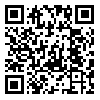Volume 10, Issue 3 (fall 2006)
jwss 2006, 10(3): 277-287 |
Back to browse issues page
Download citation:
BibTeX | RIS | EndNote | Medlars | ProCite | Reference Manager | RefWorks
Send citation to:



BibTeX | RIS | EndNote | Medlars | ProCite | Reference Manager | RefWorks
Send citation to:
O. Rafieyan, A. A. Darvishsefat, M. Namiranian. The Area Change Detection in the Northern Forests of Iran Using ETM + Data . jwss 2006; 10 (3) :277-287
URL: http://jstnar.iut.ac.ir/article-1-584-en.html
URL: http://jstnar.iut.ac.ir/article-1-584-en.html
Abstract: (27443 Views)
The aim of this study was to detect change of the forest area in the north of Iran between 1994 and 2001. The study area was covered by a 1:25000 topographic map (about 15000 ha) in Babol forests. The forest map of 1994 was extracted from 1:25000 topographic digital map. Landsat 7 ETM+ image dated July 30, 2001 was analyzed to produce the forest map for the end of the period. Since the evaluation of the image quality illustrated it less than ±1DN in the ETM 2, 4, 5, the rectification of the stripping distortion was ignored. There were also duplicate scan lines and sweep distortions in all the spectral bands. Orthorectification was implemented using ephemeris data and digital elevation model. Several spectral transformations such as rationing, PCA, Tasseled cap and image fusion (using Color space transformation and Spectral response method) were performed on the ETM+ data. The sample ground-truth map was prepared using GPS in 3% of the study area. In order to classify the image, hybrid classification method (digital and visual), using original and synthetic bands, was employed. At first the image was classified using maximum likelihood classifier. The most accurate map (overall accuracy and kappa coefficient equal to 94.56% and 0.89, respectively) was converted to the vector format and then it was edited on the basis of various color composites, fused images and other ancillary data. The obtained map showed overall accuracy and kappa coefficient equal to 96.39% and 0.927, respectively. The comparison of the classified map with the forest map of 1994, illustrated that 751 ha of forest area (equal to 8.2% of the previous forest area), were decreased. This includes a 417 ha increase (mostly reforested areas) and a 1168 ha decrease over the study period. The findings indicate the high potential of ETM+ data in forest mapping and change detection over the whole extent of the northern forest of Iran.
Keywords: Forest map, Change detection, Remote sensing, Landsat 7, Image classification, Ground-truth map.
| Rights and permissions | |
 |
This work is licensed under a Creative Commons Attribution-NonCommercial 4.0 International License. |





